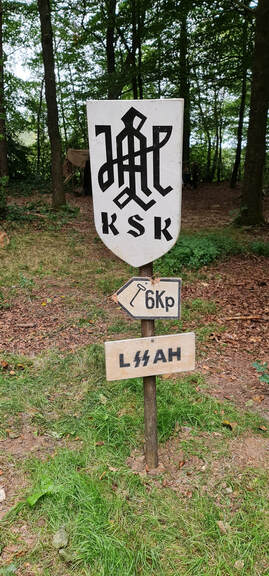
SS-Panzer-Division Leibstandarte SS Adolf Hitler (LSSAH or LAH) was formed 17 March 1933 as SS-Stabswache Berlin by Josef "Sepp" Dietrich, Hitler's bodyguard, on the order of Adolf Hitler who wanted a full-time armed force that was completly loyal to him.
It was soon redesignated SS-Sonderkommando Zossen and a new unit, SS-Sonderkommando Jüterbog, was raised. These units merged in September 1933 and was designated SS-Leibstandarte Adolf Hitler (LAH). The members of LAH took an oath of loyalty to Hitler 9 November 1933 (the 10th anniversary of the failed Beer Hall Putsch). It was redesignated Leibstandarte SS Adolf Hitler (LSSAH) in 1934.
LSSAH took part in the annexation of Austria as a part of XVI. Armee-Korps under General Heinz Guderian and later in the invasion of Czechoslovakia.
It was attached to Heeresgruppe Süd during the invasion of Poland and saw its first action along the Prosna river.
It later took part in the invasion of France and the Low Countries were it was mainly held in reserve though it was used against the retreating British troops at Dunkirk. LSSAH was attached to XIV Armeekorps during the second and final phase of the invasion of France.
Following the armistice the LSSAH was to rest and be upgraded to a brigade while training in amphibious warfare for the planned invasion of Britain (Unternehmen Seelöwe). This invasion was cancelled and LSSAH was transferred to Romania for the invasion of the Balkans. It fought its way through Yugoslavia and Greece chasing the Allied troops to Kalamata, from where they were evacuated by sea to Crete.
LSSAH took part in Unternehmen Barbarossa (the invasion of the Soviet Union) attached to Heeresgruppe Süd and saw action at Kiev and Rostov. It was transferred to France for refitting 1942 and was upgraded to a Panzergrenadier-Division. It returned to the Eastern front 1943 and fought at Kharkov and Kursk. After the failure at Kursk, LSSAH was sent to Italy on anti-partisan duty but it soon was sent back to the Eastern front this time as a Panzer-Division. LSSAH was one of the divisions encircled near Kamenets-Podolsk and though it was saved by 9. SS-Panzer-Division Frundsberg and 10. SS-Panzer-Division Hohenstaufen it suffered heavy losses and was sent to France for rest and refitting.
It fought in Normandy following the Allied invasion and saw action at Caen, Falaise and Aachen as it was pressed back towards Germany. It took part in the offensive in the Ardennes attached to I SS Panzerkorps. After the failure of that offensive LSSAH was once again sent to the Eastern front to take part in the offensive to break the siege of Budapest (Unternehmen Margarethe). Following that failed offensive it was transferred to Austria where it surrendered to the American troops at the end of the war.
It was soon redesignated SS-Sonderkommando Zossen and a new unit, SS-Sonderkommando Jüterbog, was raised. These units merged in September 1933 and was designated SS-Leibstandarte Adolf Hitler (LAH). The members of LAH took an oath of loyalty to Hitler 9 November 1933 (the 10th anniversary of the failed Beer Hall Putsch). It was redesignated Leibstandarte SS Adolf Hitler (LSSAH) in 1934.
LSSAH took part in the annexation of Austria as a part of XVI. Armee-Korps under General Heinz Guderian and later in the invasion of Czechoslovakia.
It was attached to Heeresgruppe Süd during the invasion of Poland and saw its first action along the Prosna river.
It later took part in the invasion of France and the Low Countries were it was mainly held in reserve though it was used against the retreating British troops at Dunkirk. LSSAH was attached to XIV Armeekorps during the second and final phase of the invasion of France.
Following the armistice the LSSAH was to rest and be upgraded to a brigade while training in amphibious warfare for the planned invasion of Britain (Unternehmen Seelöwe). This invasion was cancelled and LSSAH was transferred to Romania for the invasion of the Balkans. It fought its way through Yugoslavia and Greece chasing the Allied troops to Kalamata, from where they were evacuated by sea to Crete.
LSSAH took part in Unternehmen Barbarossa (the invasion of the Soviet Union) attached to Heeresgruppe Süd and saw action at Kiev and Rostov. It was transferred to France for refitting 1942 and was upgraded to a Panzergrenadier-Division. It returned to the Eastern front 1943 and fought at Kharkov and Kursk. After the failure at Kursk, LSSAH was sent to Italy on anti-partisan duty but it soon was sent back to the Eastern front this time as a Panzer-Division. LSSAH was one of the divisions encircled near Kamenets-Podolsk and though it was saved by 9. SS-Panzer-Division Frundsberg and 10. SS-Panzer-Division Hohenstaufen it suffered heavy losses and was sent to France for rest and refitting.
It fought in Normandy following the Allied invasion and saw action at Caen, Falaise and Aachen as it was pressed back towards Germany. It took part in the offensive in the Ardennes attached to I SS Panzerkorps. After the failure of that offensive LSSAH was once again sent to the Eastern front to take part in the offensive to break the siege of Budapest (Unternehmen Margarethe). Following that failed offensive it was transferred to Austria where it surrendered to the American troops at the end of the war.
